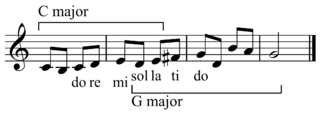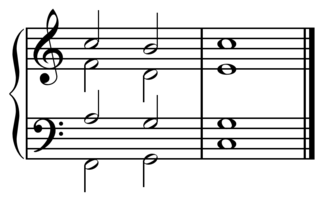In music theory, the term minor scale refers to three scale patterns – the natural minor scale, the harmonic minor scale, and the melodic minor scale – rather than just one as with the major scale.

In music, harmony is the process by which the composition of individual sounds, or superpositions of sounds, is analysed by hearing. Usually, this means simultaneously occurring frequencies, pitches, or chords.
In music, the tonic is the first scale degree of the diatonic scale and the tonal center or final resolution tone that is commonly used in the final cadence in tonal classical music, popular music, and traditional music. In the movable do solfège system, the tonic note is sung as do. More generally, the tonic is the note upon which all other notes of a piece are hierarchically referenced. Scales are named after their tonics: for instance, the tonic of the C major scale is the note C.
In music theory, a leading-tone is a note or pitch which resolves or "leads" to a note one semitone higher or lower, being a lower and upper leading-tone, respectively. Typically, the leading tone refers to the seventh scale degree of a major scale, a major seventh above the tonic. In the movable do solfège system, the leading-tone is sung as ti.
In music theory, the key of a piece is the group of pitches, or scale, that forms the basis of a music composition in classical, Western art, and Western pop music.
In music, the subdominant is the fourth tonal degree of the diatonic scale. It is so called because it is the same distance below the tonic as the dominant is above the tonic – in other words, the tonic is the dominant of the subdominant. It also happens to be the note one step below the dominant. In the movable do solfège system, the subdominant note is sung as fa.

A chord, in music, is any harmonic set of pitches consisting of multiple notes that are heard as if sounding simultaneously. For many practical and theoretical purposes, arpeggios and broken chords, or sequences of chord tones, may also be considered as chords.

In music, modulation is the change from one tonality to another. This may or may not be accompanied by a change in key signature. Modulations articulate or create the structure or form of many pieces, as well as add interest. Treatment of a chord as the tonic for less than a phrase is considered tonicization.
Modulation is the essential part of the art. Without it there is little music, for a piece derives its true beauty not from the large number of fixed modes which it embraces but rather from the subtle fabric of its modulation.
A secondary chord is an analytical label for a specific harmonic device that is prevalent in the tonal idiom of Western music beginning in the common practice period: the use of diatonic functions for tonicization.

Tonality is the arrangement of pitches and/or chords of a musical work in a hierarchy of perceived relations, stabilities, attractions and directionality. In this hierarchy, the single pitch or triadic chord with the greatest stability is called the tonic. The root of the tonic chord forms the name given to the key; so in the key of C major, the note C is both the tonic of the scale and the root of the tonic chord. Simple folk music songs often start and end with the tonic note. The most common use of the term "is to designate the arrangement of musical phenomena around a referential tonic in European music from about 1600 to about 1910". Contemporary classical music from 1910 to the 2000s may practice or avoid any sort of tonality—but harmony in almost all Western popular music remains tonal. Harmony in jazz includes many but not all tonal characteristics of the European common practice period, sometimes known as "classical music".
Function, in music, is the term used to denote the relationship of a chord or a scale degree to a tonal centre. Two main theories of tonal functions exist today:
Chromaticism is a compositional technique interspersing the primary diatonic pitches and chords with other pitches of the chromatic scale. Chromaticism is in contrast or addition to tonality or diatonicism and modality. Chromatic elements are considered, "elaborations of or substitutions for diatonic scale members".
Not only at the beginning of a composition but also in the midst of it, each scale-step [degree] manifests an irresistible urge to attain the value of the tonic for itself as that of the strongest scale-step. If the composer yields to this urge of the scale-step within the diatonic system of which this scale-step forms part, I call this process tonicalization and the phenomenon itself chromatic.
Chromaticism is almost by definition an alteration of, an interpolation in or deviation from this basic diatonic organization.
Throughout the nineteenth century, composers felt free to alter any or all chord members of a given tertian structure [chord built from thirds] according to their compositional needs and dictates. Pronounced or continuous chordal alteration [and 'extension'] resulted in chromaticism. Chromaticism, together with frequent modulations and an abundance of non-harmonicism [non-chord tones], initially effected an expansion of the tertian system; the overuse of the procedures late in the century forewarned the decline and near collapse [atonality] of the system [tonality].
Chromaticism is the name given to the use of tones outside the major or minor scales. Chromatic tones began to appear in music long before the common-practice period, and by the beginning of that period were an important part of its melodic and harmonic resources. Chromatic tones arise in music partly from inflection [alteration] of scale degrees in the major and minor modes, party from secondary dominant harmony, from a special vocabulary of altered chords, and from certain nonharmonic tones.... Notes outside the scale do not necessarily affect the tonality....tonality is established by the progression of roots and the tonal functions of the chords, even though the details of the music may contain all the tones of the chromatic scale.
Sometimes...a melody based on a regular diatonic scale is laced with many accidentals, and although all 12 tones of the chromatic scale may appear, the tonal characteristics of the diatonic scale are maintained. ... Chromaticism [is t]he introduction of some pitches of the chromatic scale into music that is basically diatonic in orientation, or music that is based on the chromatic scale instead of the diatonic scales.

A level, also "tonality level", Gerhard Kubik's "tonal step," "tonal block," and John Blacking's "root progression," is an important melodic and harmonic progression where melodic material shifts between a whole tone above and a whole tone below the tonal center. This shift can occur to both neighboring notes, in either direction, and from any point of departure. The steps above and below the tonic are often called contrasting steps. A new harmonic segment is created which then changes the tonality but not necessarily the key.

In Schenkerian analysis, the fundamental structure describes the structure of a tonal work as it occurs at the most remote level and in the most abstract form. A basic elaboration of the tonic triad, it consists of the fundamental line accompanied by the bass arpeggiation. Hence the fundamental structure, like the fundamental line itself, takes one of three forms, according to which tonic triad pitch is the primary tone. The example hereby shows a fundamental structure in C major, with the fundamental line descending from scale degree :
The Urlinie offers the unfurling (Auswicklung) of a basic triad, it presents tonality on horizontal paths. The tonal system, too, flow into these as well, a system intended to bring purposeful order into the world of chords through its selection of the harmonic degrees. The mediator between the horizontal formulation of tonality presented by the Urlinie and the vertical formulation presented by the harmonic degrees is voice leading.
The upper voice of a fundamental structure, which is the fundamental line, utilizes the descending direction; the lower voice, which is the bass arpeggiation through the fifth, takes the ascending direction. [...] The combination of fundamental line and bass arpeggiation constitutes a unity. [...] Neither the fundamental line nor the bass arpeggiation can stand alone. Only when acting together, when unified in a contrapuntal structure, do they produce art.
In music, the dominant is the fifth scale degree of the diatonic scale. It is called the dominant because it is next in importance to the first scale degree, the tonic. In the movable do solfège system, the dominant note is sung as so(l).
Post-tonal music theory is the set of theories put forward to describe music written outside of, or 'after', the tonal system of the common practice period. It revolves around the idea of 'emancipating dissonance', that is, freeing the structure of music from the familiar harmonic patterns that are derived from natural overtones. As music becomes more complex, dissonance becomes indistinguishable from consonance.
Richard Parncutt is an Australian-born academic. He has been professor of systematic musicology at Karl-Franzens-Universität Graz in Austria since 1998. His research focuses on the psychology of music.
This is a glossary of Schenkerian analysis, a method of musical analysis of tonal music based on the theories of Heinrich Schenker (1868–1935). The method is discussed in the concerned article and no attempt is made here to summarize it. Similarly, the entries below whenever possible link to other articles where the concepts are described with more details, and the definitions are kept here to a minimum.
The Unanswered Question is a lecture series given by Leonard Bernstein in the fall of 1973. This series of six lectures was a component of Bernstein's duties as the Charles Eliot Norton Professor of Poetry for the 1972/73 academic year at Harvard University, and is therefore often referred to as the Norton Lectures. The lectures were both recorded on video and printed as a book, titled The Unanswered Question: Six Talks at Harvard.
Harmony is a perceptual property of music, and along with melody, one of the building blocks of Western music. Its perception is based on consonance, a concept whose definition has changed various times throughout Western music. In a psychological approach, consonance is a continuous variable. Consonant pitch relationships are described as sounding more pleasant, euphonious, and beautiful than dissonant relationships which sound unpleasant, discordant, or rough.





